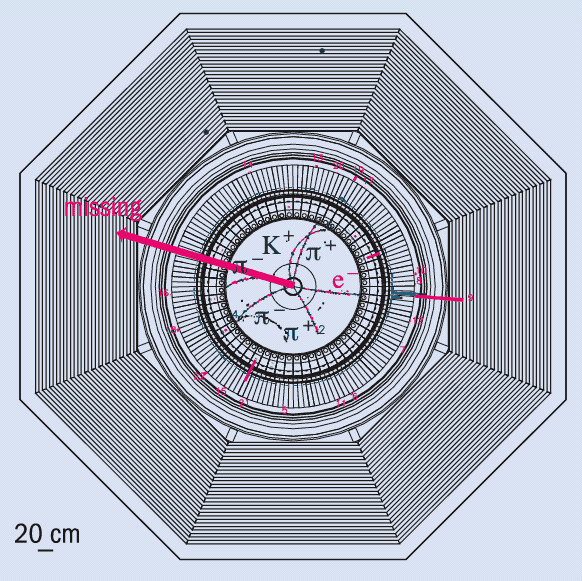The Belle experiment has recently revealed evidence for a rare and long-sought missing-energy decay of the B meson, B– → τ–ν. This has allowed the Belle Collaboration to measure the B-meson decay constant, fB, for the first time. The results were announced at the Flavor Physics and CP Violation conference in Vancouver, and have been submitted to Physical Review Letters (Ikado et al. 2006).

The Belle experiment is a collaborative effort of scientists from universities and laboratories in America, Asia, Australia and Europe. It operates at the KEK High Energy Physics Laboratory in Japan – home to KEKB, the world’s highest-luminosity particle accelerator, which recently achieved a peak luminosity of 1.6 × 1034 cm-2s-1.
In the decay mode B– → τ–ν, the B meson (a strongly interacting bound state of a b quark and anti-u quark) transforms into a final state containing only leptons. Previously, because this decay process had not been seen, researchers had to rely entirely on either calculations in lattice quantum chromodynamics (QCD) or models to obtain the parameter fB, which is needed to interpret many other measurements in particle physics, including the Cabibbo-Kobayashi-Maskawa unitarity triangle constraints from Bd-Bbard mixing.
The decay mode B– → τ–ν is especially hard to find. Not only is it rare – about 1 in 10,000 charged B decays contains such an event – but tau leptons often decay to an electron or muon together with two neutrinos, which escape the detector unseen. This means that the experimental signature is simply a single charged track accompanied by missing energy, and is frequently mimicked by less-interesting background processes.
The Belle experiment operates at the U(4S) resonance where each B meson is produced accompanied by an anti-B meson partner and nothing else. The experimental breakthrough that allowed the discovery of the missing-energy decay mode involved detecting all the decay products of the B meson accompanying the sought-after decay, thereby constraining the energy and momentum of the missing or undetected particles. This technique has a very low efficiency and is only possible because of the unprecedented luminosity of the KEKB accelerator, which provided the Belle experimenters with 457 million charged B mesons to study. Even so, this was barely sufficient to discover this rare and unusual process.
Based on the events that they have found, the Belle team reports a preliminary value of fB = 176+28-23 (stat.) +20-19 (syst.) MeV, which is compatible with the most recent calculations in unquenched lattice QCD. Conversely, if fB is taken from lattice QCD, the Belle measurement of B → τν gives a tight constraint on charged Higgs masses at high tanβ in extensions of the Standard Model, where tanβ is the ratio of vacuum expectation values.
This breakthrough in the detection of a rare missing-energy decay is the first step towards the observation of exotic decays such as B → Kννbar, B → dark matter, and other possible types of unusual and new physics processes. Although the experimental technique for observing a rare missing-energy mode has now been established, two orders of magnitude more BBbar pairs are probably needed to find B → Kννbar and exploit all of the possibilities this technique has to offer. This will be possible at the proposed KEK Super B-Factory facility.
Further reading
K. Ikado et al. The Belle Collaboration 2006 http://arXiv.org/pdf/hep-ex/0604018.








